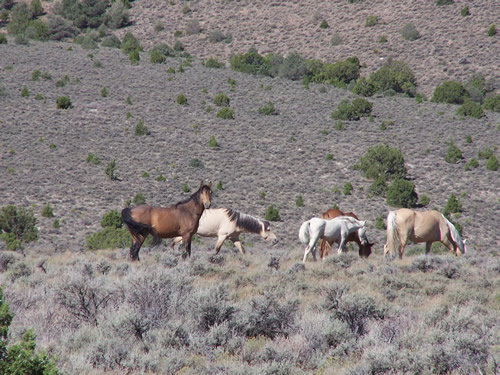
Groups argue whether these wild horses are native or feral
Recent discussion has been generated by groups who want the wild horse to be regarded as a native species and therefore force the Bureau of Land Management to manage wild horses as wildlife. The BLM now manages them as an introduced, feral animal.
People who regard them as feral say wild horses are the very definition of feral. The Merriam-Webster dictionary defines feral as an animal having escaped from domestication and become wild. Every wild horse today has ancestors that were domestic stock. Others ask how many generations spent in a wild state before a feral animal should be regarded as a wild one?
An animal named Euhippus developed on the North American continent 55 million years ago. By one million years ago, it had evolved into a species we would recognize as a horse, named Equus caballus. By 8,000 years ago, successive ice ages had lowered sea levels enough to create the Bering Land Bridge connecting North America with Asia. The horse wandered onto this land bridge, slowly grazed its way across it and entered Asia. The horses that remained on the North American continent became extinct, along with so many other mega fauna at the end of the Pleistocene Era. The horses that moved into Asia became domesticated by humans.
Roughly 500 years ago, the horse returned to North America. Christopher Columbus brought over the first domestic horses in 1493, during his second voyage. 388 years ago, in 1620, New Mexico’s Pueblo Indians revolted against the Spaniards who held them as virtual slaves. The Spaniards fled leaving behind hundreds of horses. This is the first time Native Americans are known to have owned horses and the first time horses may have escaped and become wild once again.
So, out of the last million years, the horse has been absent from the North American continent for only 7,600 years. Put another way, horses have run wild in this area for roughly 99.2% of the last million years. Does such a long occupancy qualify them as a native species?
After 1620, escaped horses quickly and easily adapted to living wild across the West. By the late 1800s, the West contained an estimated one million wild horses. Since horses are obviously genetically adapted to these arid habitats, does that qualify them as native?
The horses returned to North America were vastly different from the horses that left by walking across the Bering Land Bridge. Columbus’s horses had already undergone perhaps 3,000 years of genetic modification through selective breeding. Did such genetic manipulation produce a non-native animal?
People say the horse species developed in North America, therefore it will always be a native species and belongs here. Camels also developed on the North American continent, moved into Asia while those that stayed became extinct. Therefore, other people say camels are native and should also be returned to run wild.
It is all enough to give anyone a headache. Perhaps our time would be better spent figuring out better ways to manage wild horses, regardless of their status.